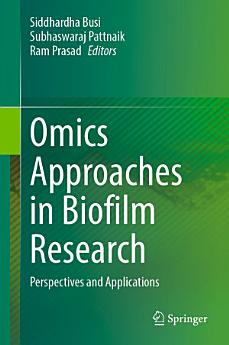Omics Approaches in Biofilm Research: Perspectives and Applications
About this ebook
Based on the advancement in omics-based tools, “Omics Approaches in Biofilm Research: Perspectives and Applications” integrates the current knowledge of biofilm microenvironment and innovative strategies to address biofilm mediated drug resistance. This work provides a comprehensive platform to enhance our knowledge, diagnosis and strategies to mitigate biofilms and associated diseases.
About the author
Dr. Siddhardha Busi, Ph.D. is an Associate Professor in the Department of Microbiology, Pondicherry University, India. He obtained his PhD from the Biology Division at CSIR-IICT in Hyderabad, India. Dr. Siddhardha has nearly 13 years of research experience in the fields of Microbiology, Microbial Pathogenesis, Antimicrobial drug discovery, and Nanobiotechnology. He has dedicated the past 13 years to the research and development of antimicrobial compounds and the discovery of antimicrobial drugs.
Dr. Subhaswaraj Pattnaik, Ph.D. is an Assistant Professor in the Department of Zoology, Govt. Women’s College, Sambalpur University, Sambalpur, Odisha, India. He obtained his Ph.D. from the Department of Microbiology, School of Life Sciences, Pondicherry University, Puducherry, India. He completed his Post-Doctoral Research (National-Post-doctoral Fellowship program from DST-SERB, Govt. of India) in the Department of Biotechnology and Bioinformatics, Sambalpur University, Sambalpur, Odisha, India.
the mitigation of bacterial quorum sensing regulatory network and biofilm-associated infections, particularly in ESKAPE pathogens. He is extensively working in the field of identifying bioactive compounds from natural resources in the therapeutic management of biofilm-associated chronic infections in ESKAPE pathogens by targeting species-specific quorum sensing communication by exploring the analytical techniques and bioinformatics-based molecular tools. He is also working on the development of therapeutic moieties against UTIs using plant-derived compounds and sustainable nano-based drug formulation for the efficient management of antibiotic resistance by regulation of bacterial biofilm mechanics. Dr. Pattnaik has more than fifty publications to his credit, including several research and review papers in peer-reviewed international journals, and several book chapters in the edited books of reputed publishing groups. He is also a member of many national and international scientific societies.
Ram Prasad, Ph.D. is Associate Professor, Department of Botany, Mahatma Gandhi Central University, Motihari, Bihar, India. His research interests include applied & environmental microbiology, plant-microbe interactions, sustainable agriculture, chemistry of biology, and nanobiotechnology. Dr. Prasad has more than 250 publications to his credit including research papers, review articles & book chapters, seven patents issued or pending, and several edited or authored books. Dr. Prasad has 12 years of teaching experience and has been awarded the Young Scientist Award & Prof. J.S. Datta Munshi Gold Medal by the International Society for Ecological Communications; Fellow of Biotechnology Research Society of India; Fellow of the Society for Applied Biotechnology; the American Cancer Society UICC International Fellowship for Beginning Investigators, USA; Outstanding Scientist Award in the field of Microbiology by Venus International Foundation; BRICPL Science Investigator Award and Research Excellence Award etc. He has been serving as an editorial board member: Nanotechnology Reviews; Green Processing and Synthesis; BMC Microbiology; BMC Biotechnology; Current Microbiology; Archives of Microbiology; Annals of Microbiology; BioMed Research International,




